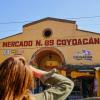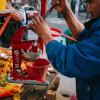
A cultural guide to Mexico City
By Hamish Anderson
March 2024
Be pulled in by the magnetism of this effortlessly cool and charismatic city, where ancient sites meet cutting-edge art and design
Your essential guide to the best things to see and do in Mexico City. Find more travel inspiration for more amazing cities here.
It’s hard to imagine now, but much of Mexico City’s urban sprawl was once a lake, drained by the Spanish as part of their conquest. Today, the city’s “three cultures” are literally layered on top of each other: ancient Aztec buildings below Spanish-colonial architecture, beside buildings constructed after independence in 1821.

The famed Palacio de Bellas Artes in the Centro Histórico
Amid all this, CDMX, as it’s often called, has a vibrant present, with the once-maligned Mexican capital earning its place as an “it” destination among in-the-know travelers. And for good reason: It’s now a buzzing cultural juggernaut, packed with museums and galleries, world-class taquerias and innovative restaurants, a vibrant film and fashion scene, live music, and irrepressible street life.
Whether you come for an activity-packed weekend or a more leisurely visit, there’s almost too much to fit in, so your first trip is unlikely to be your last.
Art & architecture
Cover 400 years of Mexican architecture in one square block, drinks included: Start at the Palacio de Bellas Artes, which combines art nouveau, art deco and neoclassical styles, and is renowned for its murals by Diego Rivera and his contemporaries. Across the street is the Correo Mayor, or central post office: Don’t mail anything (Mexico’s postal service is terrible), but do go inside to enjoy the extraordinary gilded architecture.
Down the block, head up to the 44th-floor open-air viewing platform of Torre Latino (the building may remind you of New York’s Empire State), which offers a spectacular way to orient yourself and see how Mexico’s chaotic mix of architectural history coexists. Either have a snack and a drink there, or go around the corner to the Casa de los Azulejos, a tile-encrusted baroque marvel that happens to serve very solid enchiladas.

Take a Trajinera tour of the Xochimilco canals, south of the city

Frida Kahlo’s Casa Azul is unmissable in more ways than one
For contemporary galleries and other handsome buildings, visit Roma Norte (where you’ll find Maia and OMR), and San Miguel Chapultepec (for Kurimanzutto, JO-HS and more). Meanwhile, architecture and design fans should add Casa Luis Barragán in Colonia Ampliación to their itineraries. The 1948 abode served as the home and studio of Luis Barragán, the Pritzker Prize-winner who revolutionized modern architecture in Mexico by incorporating traditional elements such as bright colors and textures. And no cultural exploration of Mexico City would be complete without a visit to Casa Azul, the former home of artist-turned-pop-culture icon Frida Kahlo, now a museum. Be sure to book your tickets in advance.
Expert tips
The essentials
Fly to Mexico City International Airport (MEX). The Line 4 Metrobus from terminals 1 and 2 takes 30 minutes to reach the city center.
A 10% tip after a meal is standard. Tipping is not expected for street food, but a simple “keep the change” gesture would be appreciated. Mexico City is the largest Spanish-speaking city in the world; hola (hello) and gracias (thank you) are useful starting phrases.
Getting around
The cheapest way to quickly get around the city is via the Metro. If you are a female traveler, consider using the first two carriages, which are reserved for women and children. Another affordable option is the MetroBús. Purchase a smartcard at Metro vending machines ahead of boarding. Taxis and ride-hailing apps also operate in Mexico City, and are the most convenient and popular method of getting around. Many of Mexico City’s neighborhoods are best explored on foot, particularly Roma and Condesa. Regina and San Jerónimo streets in the center are fully pedestrianized and stay open late.
Accessibility
There are no elevators in Metro stations, making accessibility limited. The Metrobús is free for passengers with disabilities, and is accessible. Several top attractions like Zócalo, the Metropolitan Cathedral, and many museums are accessible. The National Museum of Anthropology offers facilities for visually impaired visitors, including audio guides and tactile exhibits.
LGBTQ+
Zona Rosa (the Pink Zone) is a popular LGBTQ+ neighborhood known for its vibrant nightlife, bars and LGBTQ+ friendly establishments. Mexico City Pride, known as Marcha del Orgullo, takes place in June with a lively parade along Reforma Avenue.
Food & drink
Mexico City has great food at every price point. Be aware that lunch is the main meal of the day (some restaurants don’t open for dinner) and tends to start at 2–3 p.m. For street tacos, try the suadero (brisket slow-cooked in lard) at Taquería Los Cocuyos, and al pastor at Los Parados. If you prefer to sit while you eat, Coyoacán Market near the Frida Kahlo museum is a tourist-friendly destination with delicious food of all kinds. For a more luxurious experience, seek out Contramar for seafood and chef Enrique Olvera’s Pujol for a modernist take on cuisines from all regions of Mexico. For food that’s not really Mexican but is popular with Mexicans, try Rosetta (modern Italian in a gorgeous space) and Meroma (contemporary, eclectic, ingredient-driven).

Find local fare at the colorful Coyoacàn Market

Squeeze in a fresh fruit juice on hot days
Music
For club sounds, try Departamento (note: It gets busy), or Fünk. Live salsa can be found at venues including Mama Rumba and San Luis Club. At the latter, keep a note of what you drink: Sometimes the waiters’ math skills are less than perfect, though the musicians are always on point. Mexico City also has several major festivals with international acts in spring and autumn, including Corona Capital, Vive Latino, and Ceremonia.
While Colonia Juárez is the city’s current trending neighborhood, you’ll find a nice assortment of boutique hotels and inns in these two adjacent parts of town. They’re also fashionable, walkable and packed with galleries, concept shops, record stores, restaurants, bars and parks. (The southern part of Roma may also look familiar if you saw the film of the same name, which was shot there.)
Stay at Hotel San Fernando near Condesa’s Parque México: Built as apartments in 1947, it retains many of the original deco-inspired architectural details that are emblematic of the neighborhood. Bonus: The rooftop bar is a nice modernizing touch.
Rather than a neighborhood, this is one of Mexico City’s main boulevards, housing many of the big international hotels such as the Marriott, Four Seasons, Sheraton, Sofitel, and the Ritz-Carlton, which is notable for its spectacular views of the city (even if you don’t stay there, do visit the 38th-floor sky bar for a sunset drink). Reforma also gives you easy access to museums such as the Tamayo and the National Museum of Anthropology, plus many neighborhoods of interest, from the swanky Polanco to the bohemian Juárez.
Mexico City’s historic center combines notable tourist sites with contemporary commerce and street life. There’s plenty to see, from archeological excavations to a host of murals. It’s fascinating but can be overwhelming, so stay somewhere like the Gran Hotel Ciudad de México, which feels like an oasis of calm despite its central location. One of the city’s most beautiful, the hotel is housed in a gorgeous art-nouveau building featuring a stunning stained-glass lobby ceiling and rooftop restaurant overlooking the Zócalo (Main Square).

Hamish Anderson is a culture writer specializing in food and travel. His work has appeared in T Magazine, the Wall Street Journal, Elle and Saveur. He is based between Mexico City and Brooklyn.
